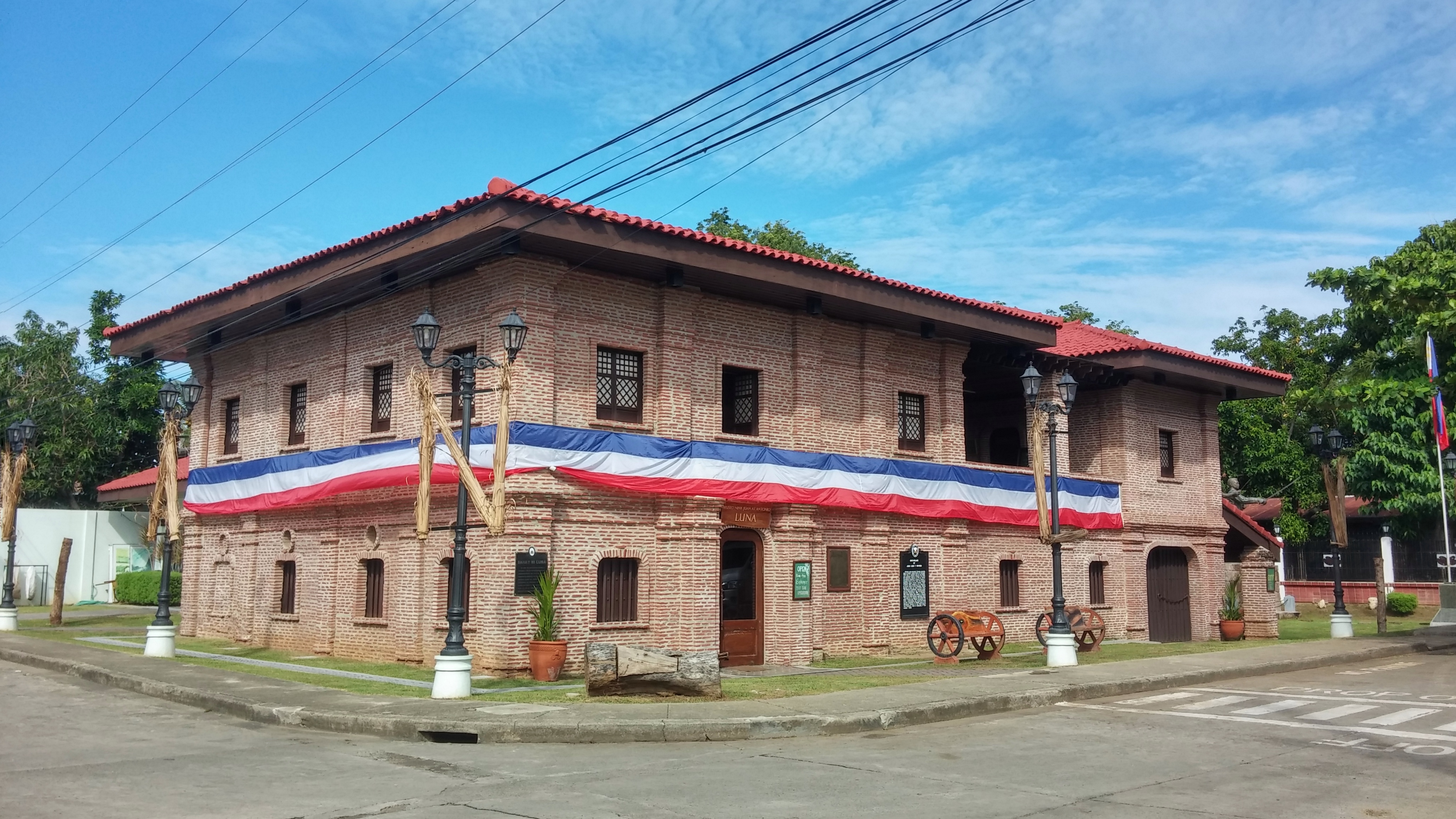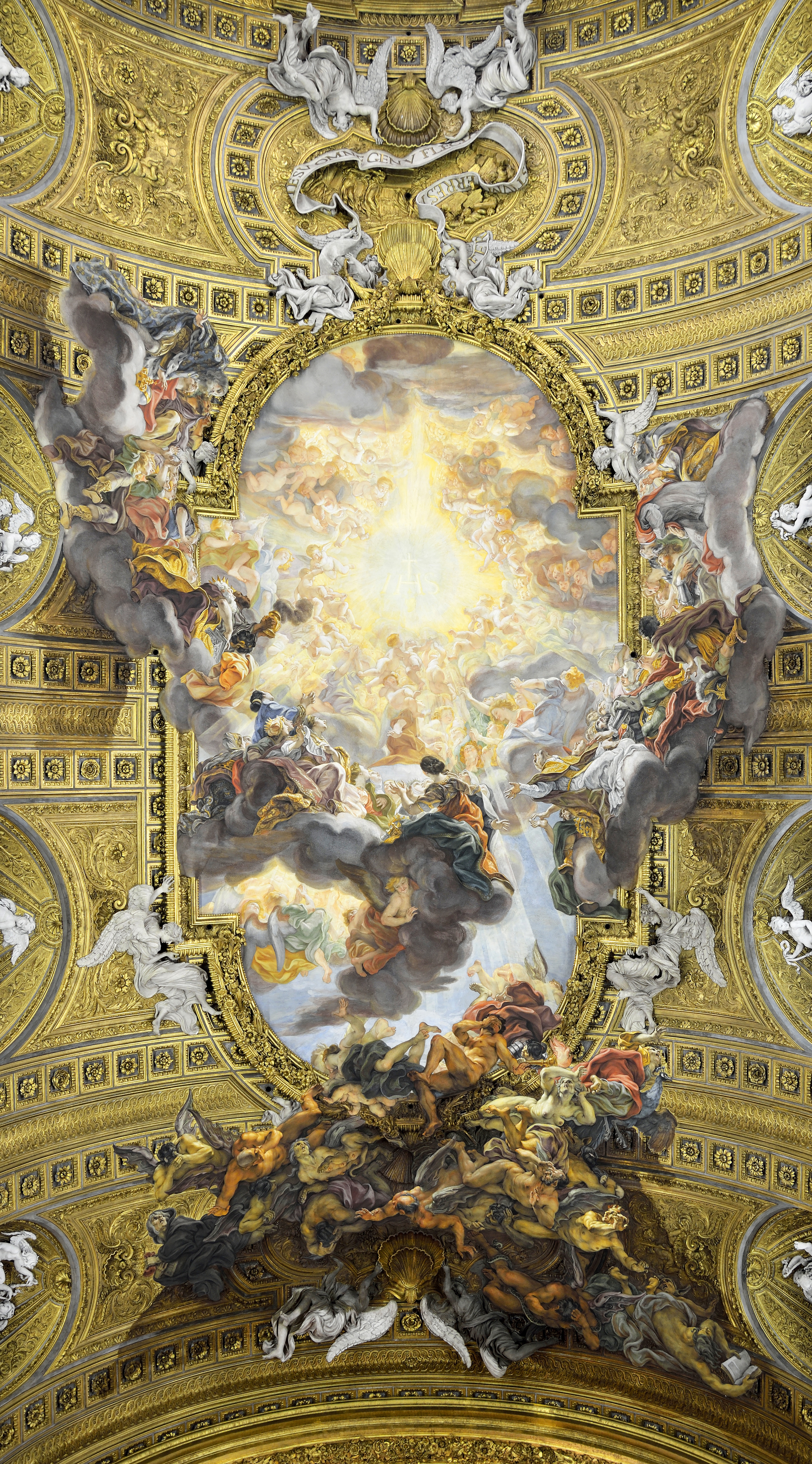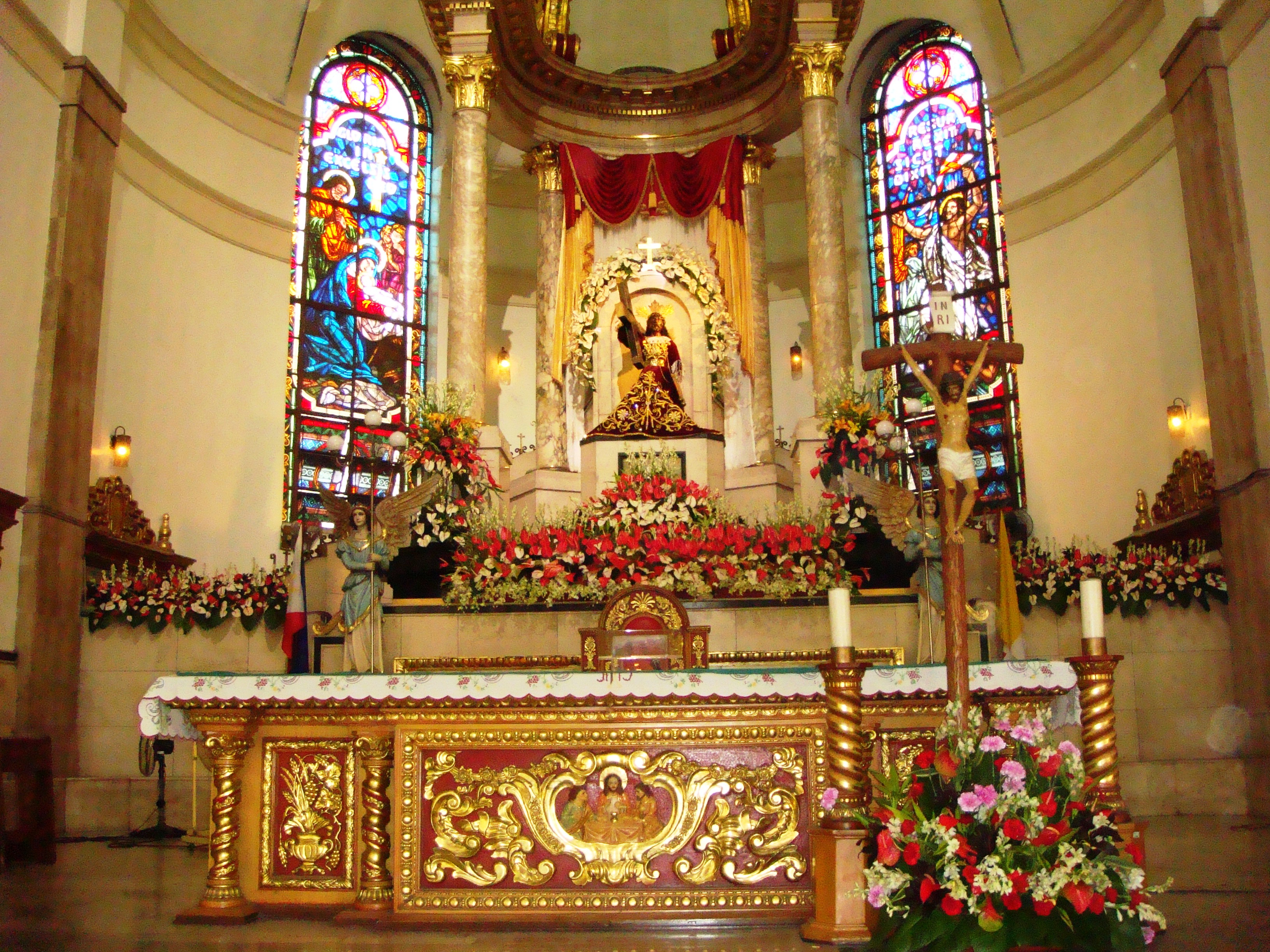|
Badoc Basilica
The Saint John the Baptist Basilica, also known as the Shrine of La Virgen Milagrosa de Badoc, is a Roman Catholic church in Badoc, in the northern Philippine province of Ilocos Norte. The basilica houses the Virgin Milagrosa statue of the Virgin Mary. It is dedicated to John the Baptist and has the title of a minor basilica since 2018. It was built in the 17th century in the Baroque style. History The architect of the church is Brother Antonio Estavillo, OSA, who also built the Church of St. Augustine in Paoay, which is recognized as a world heritage site. It is one of the eleven Baroque Fil Hispanic churches in Ilocos Norte. The side walls of the single-nave church are reinforced with massive buttress walls to protect against earthquakes. To the left of the entrance to the church is a bell tower. The church was converted into a parish church in 1714 when it was separated from the parish of St. Nicholas of Tolentino (now also a basilica) in Sinait. In November 2018 the elev ... [...More Info...] [...Related Items...] OR: [Wikipedia] [Google] [Baidu] |
Badoc
Badoc, officially the Municipality of Badoc ( ilo, Ili ti Badoc; tl, Bayan ng Badoc), is a 3rd class municipality in the province of Ilocos Norte, Philippines. According to the 2020 census, it has a population of 32,530 people. It is the birthplace of Filipino painter, Juan Luna. The tourist spots in this town are Luna Shrine, Luna Park, Badoc Island, Badoc Church and La Virgin Milagrosa Shrine and beautiful beaches. Geography Badoc is from Metro Manila and from Laoag City, the provincial capital. Barangays Badoc is politically subdivided into 31 barangays. These barangays are headed by elected officials: Barangay Captain, Barangay Council, whose members are called Barangay Councilors. All are elected every three years. Climate Demographics In the 2020 census, the population of Badoc was 32,530 people, with a density of . Economy Places of interest La Virgen Milagrosa Badoc houses the Sanctuary of the Miraculous Statue of the Blessed Virgin Mary, the La Virg ... [...More Info...] [...Related Items...] OR: [Wikipedia] [Google] [Baidu] |
Marian Shrine
A shrine to the Virgin Mary (or Marian shrine) is a shrine marking an Marian apparitions, apparition or other miracle ascribed to the Blessed Virgin Mary, or a site on which is centered a historically strong Blessed Virgin Mary, Marian devotion. Such locales are often the destination of pilgrimages. Albania *Sanctuary of Our Lady of Good Counsel, Shkodër Algeria *Notre Dame d'Afrique, Algiers Andorra * Our Lady of Meritxell Argentina *Our Lady of Luján, Luján, Buenos Aires Province *Our Lady of the Rosary of San Nicolás, San Nicolás de los Arroyos *Our Lady of Itatí, Itatí, Corrientes Australia * St Mary's Cathedral, Sydney * Shrine of Our Lady of Yankalilla, South Australia * Shrine of Our Lady of Mercy, Penrose Park, New South Wales * Marian Valley, Shrine of Our Lady Help of Christians, Canungra, Queensland Austria *:de:Maria Plain, Basilika Maria Plain, Bergheim, Austria, Bergheim, Salzburg * Maria Schmolln, Braunau am Inn District, Upper Austria *Maria Taferl, ... [...More Info...] [...Related Items...] OR: [Wikipedia] [Google] [Baidu] |
Basilica Churches In The Philippines
In Ancient Roman architecture, a basilica is a large public building with multiple functions, typically built alongside the town's forum. The basilica was in the Latin West equivalent to a stoa in the Greek East. The building gave its name to the architectural form of the basilica. Originally, a basilica was an ancient Roman public building, where courts were held, as well as serving other official and public functions. Basilicas are typically rectangular buildings with a central nave flanked by two or more longitudinal aisles, with the roof at two levels, being higher in the centre over the nave to admit a clerestory and lower over the side-aisles. An apse at one end, or less frequently at both ends or on the side, usually contained the raised tribunal occupied by the Roman magistrates. The basilica was centrally located in every Roman town, usually adjacent to the forum and often opposite a temple in imperial-era forums. Basilicas were also built in private residences and ... [...More Info...] [...Related Items...] OR: [Wikipedia] [Google] [Baidu] |
Baroque Architecture In The Philippines
The Baroque (, ; ) is a style of architecture, music, dance, painting, sculpture, poetry, and other arts that flourished in Europe from the early 17th century until the 1750s. In the territories of the Spanish and Portuguese empires including the Iberian Peninsula it continued, together with new styles, until the first decade of the 19th century. It followed Renaissance art and Mannerism and preceded the Rococo (in the past often referred to as "late Baroque") and Neoclassical styles. It was encouraged by the Catholic Church as a means to counter the simplicity and austerity of Protestant architecture, art, and music, though Lutheran Baroque art developed in parts of Europe as well. The Baroque style used contrast, movement, exuberant detail, deep colour, grandeur, and surprise to achieve a sense of awe. The style began at the start of the 17th century in Rome, then spread rapidly to France, northern Italy, Spain, and Portugal, then to Austria, southern Germany, and Russia. By ... [...More Info...] [...Related Items...] OR: [Wikipedia] [Google] [Baidu] |
17th-century Roman Catholic Church Buildings In The Philippines
The 17th century lasted from January 1, 1601 ( MDCI), to December 31, 1700 ( MDCC). It falls into the early modern period of Europe and in that continent (whose impact on the world was increasing) was characterized by the Baroque cultural movement, the latter part of the Spanish Golden Age, the Dutch Golden Age, the French ''Grand Siècle'' dominated by Louis XIV, the Scientific Revolution, the world's first public company and megacorporation known as the Dutch East India Company, and according to some historians, the General Crisis. From the mid-17th century, European politics were increasingly dominated by the Kingdom of France of Louis XIV, where royal power was solidified domestically in the civil war of the Fronde. The semi-feudal territorial French nobility was weakened and subjugated to the power of an absolute monarchy through the reinvention of the Palace of Versailles from a hunting lodge to a gilded prison, in which a greatly expanded royal court could be more easily ... [...More Info...] [...Related Items...] OR: [Wikipedia] [Google] [Baidu] |
Baroque Church Buildings In The Philippines
The Baroque (, ; ) is a style of architecture, music, dance, painting, sculpture, poetry, and other arts that flourished in Europe from the early 17th century until the 1750s. In the territories of the Spanish and Portuguese empires including the Iberian Peninsula it continued, together with new styles, until the first decade of the 19th century. It followed Renaissance art and Mannerism and preceded the Rococo (in the past often referred to as "late Baroque") and Neoclassical styles. It was encouraged by the Catholic Church as a means to counter the simplicity and austerity of Protestant architecture, art, and music, though Lutheran Baroque art developed in parts of Europe as well. The Baroque style used contrast, movement, exuberant detail, deep colour, grandeur, and surprise to achieve a sense of awe. The style began at the start of the 17th century in Rome, then spread rapidly to France, northern Italy, Spain, and Portugal, then to Austria, southern Germany, and Russia. By ... [...More Info...] [...Related Items...] OR: [Wikipedia] [Google] [Baidu] |
Roman Catholic Churches In Ilocos Norte
Roman or Romans most often refers to: *Rome, the capital city of Italy *Ancient Rome, Roman civilization from 8th century BC to 5th century AD *Roman people, the people of ancient Rome *''Epistle to the Romans'', shortened to ''Romans'', a letter in the New Testament of the Christian Bible Roman or Romans may also refer to: Arts and entertainment Music *Romans (band), a Japanese pop group * ''Roman'' (album), by Sound Horizon, 2006 * ''Roman'' (EP), by Teen Top, 2011 *"Roman (My Dear Boy)", a 2004 single by Morning Musume Film and television *Film Roman, an American animation studio * ''Roman'' (film), a 2006 American suspense-horror film * ''Romans'' (2013 film), an Indian Malayalam comedy film * ''Romans'' (2017 film), a British drama film * ''The Romans'' (''Doctor Who''), a serial in British TV series People *Roman (given name), a given name, including a list of people and fictional characters *Roman (surname), including a list of people named Roman or Romans *Ῥωμαῖ ... [...More Info...] [...Related Items...] OR: [Wikipedia] [Google] [Baidu] |
Canonical Coronation
A canonical coronation ( la, Coronatio Canonica) is a pious institutional act of the pope, duly expressed in a bull, in which the pope bestows the right to impose an ornamental crown, a diadem or an aureole to an image of Christ, Mary or Joseph that is widely venerated in a particular diocese or locality. The formal act is generally carried out by a representing proxy of the pope, via the designated apostolic nuncio to a country or kingdom, or at times a lesser papal legate, or on rare occasions by the pope himself, by ceremonially attaching a crown, tiara, or stellar halo to the devotional image or statue. The Holy Office originally issued the authorisation of a canonical coronation through a dicastery, called the "Vatican Chapter". Subsequently, until 1989, the Vatican's Sacred Congregation of Rites was assigned this duty. Since then, the Congregation for Divine Worship and the Discipline of the Sacraments arranges to execute the ceremonial act which the decree authorizes. ... [...More Info...] [...Related Items...] OR: [Wikipedia] [Google] [Baidu] |
Black Nazarene
The Black Nazarene ( es, El Nazareno Negro, Nuestro Padre Jesús Nazareno; fil, Poóng Itím na Nazareno, Hesus Nazareno) is a life-sized image of a dark-skinned, kneeling Jesus Christ carrying the Cross enshrined in the Minor Basilica of the Black Nazarene in the Quiapo district of the City of Manila, Philippines. The dark wooden image was carved by an anonymous Mexican artist in the 16th century and then brought to the Philippines in 1606. It depicts Jesus en route to his crucifixion. Pope Innocent X granted recognition to the lay Confraternity of Santo Cristo Jesús Nazareno in 1650 for the promotion of the devotion to Jesus through the icon. It was housed in various churches near Manila in the early decades, arriving in Quiapo Church in 1787 where it has been enshrined ever since. The icon is renowned in the Philippines and is considered by many Filipino Catholics to be miraculous; its mere touch is reputed to cure disease. It attracts homage from numerous devotees, who ... [...More Info...] [...Related Items...] OR: [Wikipedia] [Google] [Baidu] |
Japan
Japan ( ja, 日本, or , and formally , ''Nihonkoku'') is an island country in East Asia. It is situated in the northwest Pacific Ocean, and is bordered on the west by the Sea of Japan, while extending from the Sea of Okhotsk in the north toward the East China Sea, Philippine Sea, and Taiwan in the south. Japan is a part of the Ring of Fire, and spans Japanese archipelago, an archipelago of List of islands of Japan, 6852 islands covering ; the five main islands are Hokkaido, Honshu (the "mainland"), Shikoku, Kyushu, and Okinawa Island, Okinawa. Tokyo is the Capital of Japan, nation's capital and largest city, followed by Yokohama, Osaka, Nagoya, Sapporo, Fukuoka, Kobe, and Kyoto. Japan is the List of countries and dependencies by population, eleventh most populous country in the world, as well as one of the List of countries and dependencies by population density, most densely populated and Urbanization by country, urbanized. About three-fourths of Geography of Japan, the c ... [...More Info...] [...Related Items...] OR: [Wikipedia] [Google] [Baidu] |
Nagasaki
is the capital and the largest city of Nagasaki Prefecture on the island of Kyushu in Japan. It became the sole port used for trade with the Portuguese and Dutch during the 16th through 19th centuries. The Hidden Christian Sites in the Nagasaki Region have been recognized and included in the UNESCO World Heritage List. Part of Nagasaki was home to a major Imperial Japanese Navy base during the First Sino-Japanese War and Russo-Japanese War. Near the end of World War II, the American atomic bombings of Hiroshima and Nagasaki made Nagasaki the second and, to date, last city in the world to experience a nuclear attack (at 11:02 am, August 9, 1945 'Japan Standard Time (UTC+9)'). , the city has an estimated population of 407,624 and a population density of 1,004 people per km2. The total area is . History Nagasaki as a Jesuit port of call The first contact with Portuguese explorers occurred in 1543. An early visitor was Fernão Mendes Pinto, who came from Sagres ... [...More Info...] [...Related Items...] OR: [Wikipedia] [Google] [Baidu] |
Milagrosa De Badoc
Milagrosa (formerly named Tulo) is an industrialized barangay located on the south edge of the city of Calamba, Laguna, Philippines. The barangay's name was changed from Tulo to Milagrosa through a plebiscite held on 3 December 2011. It houses various housing projects by Pag-Ibig such as in Barangay Barandal, Palo Alto, Majada-Labas and Canlubang. Geography Neighboring Barangays: *West - Punta, Kay-Anlog *East - La Mesa, Maunong, Saimisim *South - Makiling *North - Turbina ''Turbine'' ( cs, Turbina) is a 1941 Czech historical drama film directed by Otakar Vávra and starring František Smolík, Lída Baarová and Vlasta Matulová. It is based on a novel by Karel Matěj Čapek-Chod. Synopsis The film takes pl ... Population Establishments * AXEIA - Is a group of companies for housing. AXEIA development corporation and basic housing or Asiatic land .It is located at Barangay Milagrosa, Calamba City, Laguna. * National University Laguna - is the first NU univers ... [...More Info...] [...Related Items...] OR: [Wikipedia] [Google] [Baidu] |








